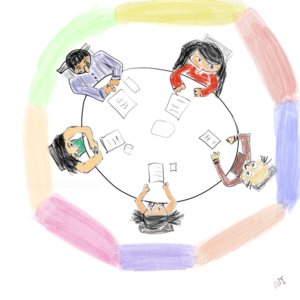
Don’t underestimate the power of open-minded conversations.
If you are like most organizations and leaders, you are experiencing disruption. You are experiencing pressure from within and outside your company. You are introducing new technology, you are facing greater competition, you have changes in leadership and focus. You worry about engagement and having the right talent. You need people to think and behave in a different way to achieve challenging goals. Sometimes it is a matter of life or death for the future of the enterprise.
For example, an organization we worked with experienced a merger where very different cultures joined. There were conflicts among leaders about where to spend resources and devote energy. There were different perceptions about what was needed with different demands from senior leadership and the external clients. The misalignment and conflicts were felt throughout the system.
We spoke with the leaders to understand their perspectives and brought them together for open-minded dialogue. They needed to align as a leadership team and organization to make a real difference for clients and to survive in the increasingly pressured marketplace.
First, the leadership team needed to build trust. This was not easy. However, once the different perspectives were shared and each identified what they needed to feel respected they found common ground and that they could see themselves as the team to succeed.
They created a shared vision and aligned around where they would focus energy.
They found synergies when they stopped fighting one another. They agreed on their roles and responsibilities and developed processes such as cadences for how they would communicate with each other and the organization.
They clarified the kind of culture they wanted and the mindset and behaviors they expected. They agreed to move from competing with each other to achieving together. They planned to move from each group acting as an island to finding and benefitting from synergies. They planned to move from excluding to respectful inclusion and dialogue. They agreed to say “we” rather than “they” when referring to each other.
There is great power in bringing a leadership team together for dialogue. Open-minded conversations are essential for transformation. No matter how compelling the need for change, it requires real understanding and agreement on how to co-create a future together. Too much energy is wasted when there is talking at one another or polite talk. There needs to be genuine understanding, alignment and agreements. Of course, the conversations need to continue among the leadership team and throughout the system.
Conversations are key to creating a shared vision and culture to achieve goals. Don’t underestimate the power of conversations for transformation. How are you promoting transformational conversations?
—
Please join us for a free, introductory Zoom online webinar on Leading the Transformational Retreat, on August 23rd @ 12:30 pm Central Time.
https://bit.ly/2M9x6O6
In this program, we will hear your challenges, offer insights and share a powerful coaching model we use to support leaders and others in creating, launching and sustaining transformation in their organizations. We will also answer questions about our upcoming half-day, live, in-person seminar program September 24th in Chicago on supporting leaders in creating, launching, and managing culture change.



 Our upbringing and experiences influence how we see the world, our mindset and how we behave. We each interpret things in a different way. When someone challenges our perspective we easily become defensive and argue for why our view is correct.
Our upbringing and experiences influence how we see the world, our mindset and how we behave. We each interpret things in a different way. When someone challenges our perspective we easily become defensive and argue for why our view is correct.




